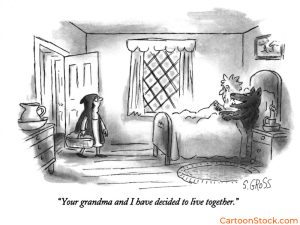
Cartoon critics Phil Witte and Rex Hesner look behind the gags to debate what makes a cartoon tick. This week our intrepid critics take a look at Grandparents.
First up is Roz Chast with a cartoon featuring a grandpa seated between two grandkids who are curious about a wondrous thing that seems to come from a fairytale. They’ve heard him explain it once, but they find the concept so intriguing they want to hear about it again. Grandpa seems pleased to oblige. Pensions have largely disappeared, but the diamond-patterned wallpaper in a Roz Chast cartoon endures.
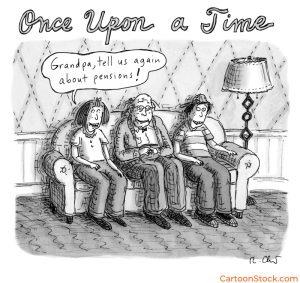
Along the same theme is a cartoon by Phil Witte, co-author of this blog. The subject is another concept from bygone days: civility. The first line of the caption puts across the gag, much like the Chast cartoon, and the second line adds a layer to the gag that’s almost poignant.
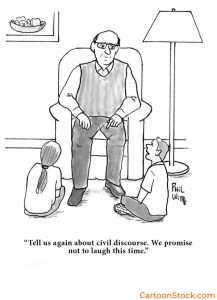
One more “tell us agin” cartoon, this one by James Stevenson featuring anthropomorphic frogs. A little knowledge of French Impressionism is needed to get the gag, of course. Stevenson depicts several lily pads receding into the distance to convey a marshy environment that inspired Monet’s late works.
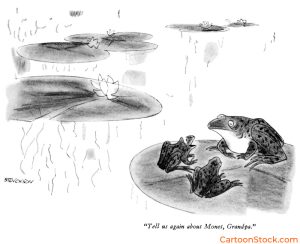
The relationships between generations are not always convivial, a point made sharply by David Sipress. The grandchild no doubt thinks Gramps has lost his mind, while Dad looks on disapprovingly. Even without the wrinkles, one can immediately determine that the speaker is elderly: he’s wearing a necktie. Incidentally, the painting on the wall looks very much like other works of art in Sipress’s cartoons, resembling a framed “grawlix,” the typographical symbols used in comic strips to represent swear words.

Here’s another Sipress cartoon, this one with an immigrant grandfather, whose memories of the Old Country are bittersweet or maybe just mixed up. The setting on the ship may have evoked recollections of entering New York Harbor on his way to Ellis Island. The grandkids are baffled.
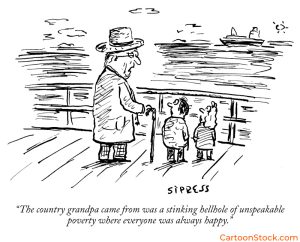
Grandmas need to get into the act, too, and Bruce Kaplan meets the challenge with a cartoon that has a Yiddish-inflected caption. She’s a bubbe not to taken lightly as she charges in, demanding her right to crow about her grandchild, but her friends don’t seem to mind. This is one of the few cartoons by BEK where two characters are smiling … three or more if you count the grandkids in the photos.
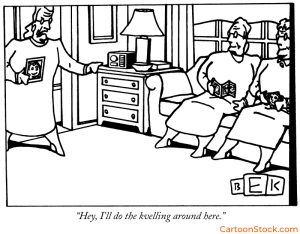
Ben Schwartz takes us back to World War II and an inspirational squad leader with a remarkable talent for accurately imagining the future. In addition to the excellent artwork—those propeller warplanes establish the timeframe—the caption is a fine example of anticlimax, stretched out over 27 words in the third sentence.

Moving along to a couple peculiar cartoons, we have two grandpas about to duke it out in a cartoon by Zach Kanin. Apparently older men lose track of their waistlines, resulting in high-pants syndrome.

When it comes to absurdist humor, few can match P.S. Mueller. Everything about this cartoon is startling: the Picassoesque treatment of the woman, the needle-like hair of the child (a boy?), the caption in an oddly shaped banner, and of course the gag itself. Mueller has a unique artistic style to go with his quirky sense of humor.

We began with a Chast cartoon with the title “Once upon a time,” and close with a fairytale-themed cartoon by the great Sam Gross. His story has a surprise ending satisfying to both Grandma and her lupine paramour, though Little R.R. probably would like to unsee this scene. And they lived happily ever after.
